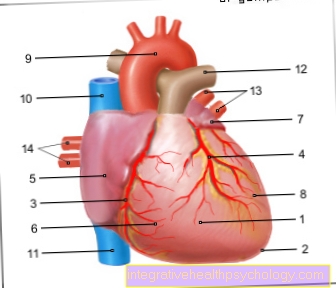Plasmacytoma Therapy
All information given here is only of a general nature, tumor therapy always belongs in the hands of an experienced oncologist!
How is plasmacytoma treated?
The therapy of plasmacytoma does not follow any fixed criteria.
Therapy must always be tailored to the patient. It takes into account the age, state of health, psyche and wishes of the patient.
The stages of Salmon and Durie and the A and B classification are used as an objective assessment standard for therapy.
In stage I, a symptom-free patient is generally not treated (dormant plasmacytoma = smoldering plasmacytoma). Regular checks of the Laboratory values is carried out in order to enable early action in the event of changes in laboratory values.
In stages II and III, one generally occurs chemotherapy. This is done by the hematologist. In addition, alpha interferon can be used for therapy.
In addition, any complications that arise are treated immediately.
If specific symptoms or complications occur, various therapy options can be used (unfortunately we can Not always guarantee that the therapies mentioned are up to date):
- Chemotherapy (Alexanian - scheme)
1. Monotherapy with melphalan and cortisone in the form of tablets; Repeat about every two weeks
2. Polychemotherapy (infusions; repeated every three to six weeks) - High-dose chemotherapy with Stem cell transplant (only in exceptional cases for young patients)
- radiotherapy
- Alpha interferon (see above) is a so-called messenger substance and acts as an endogenous active ingredient with a broad spectrum of action on the immune cells. The multiplication of plasma cells is inhibited so that it can be used for stabilization (as maintenance therapy) following chemotherapy. It is important to mention that alpha interferon as a single therapy has too little effect.
Plasmacytoma / multiple myeloma is an incurable disease. Only patients who can undergo high-dose chemotherapy with stem cell transplantation have a low probability of cure. Only a few patients are suitable for this therapy, which is also high risk.
However, if therapy is initiated in good time, the disease activity of the plasmacytoma can be suppressed so that, ideally, it can no longer be detected in the blood at times. This is called a Remission the disease. Unfortunately, this cannot be equated with a cure, as the disease can reappear after months or years (Relapse).
Radical chemotherapy is avoided, especially in poor health.
In cases of impending bone fractures due to pronounced bone loss or severe bone pain, a local radiation therapy (maximum dose of 45-50 Gray). The treatment is less of a burden for the patient. It is usually combined with chemotherapy.
What accompanying therapy measures are there?
Extensive supportive measures are available for the treatment of myeloma:
- The quality of life includes freedom from pain. Modern pain medication should be able to achieve a low level of pain. Bone pain can be very pronounced and thus affect the whole person. For pain therapy, please see our new chapter.
- Anemia can occur with the administration of Erythropoietin, a red blood cell growth factor.
- In order to reduce bone loss, so-called Bisphosphonateswhose effect is based on the inhibition of osteoclasts (= bone-degrading body cells) are used. This can prevent breaks if necessary.
- Is it already too so called pathological fractures the fracture must be stabilized in an interdisciplinary manner with the orthopedics department.





























